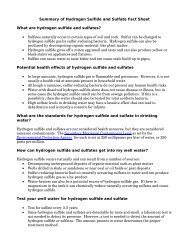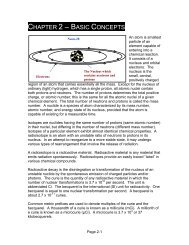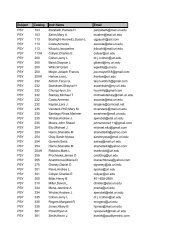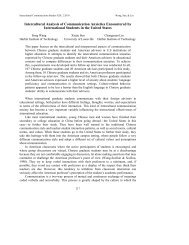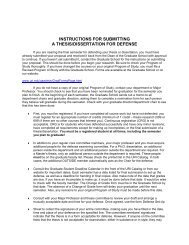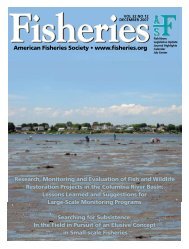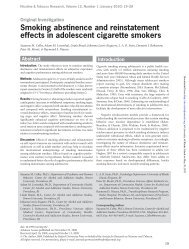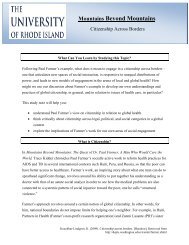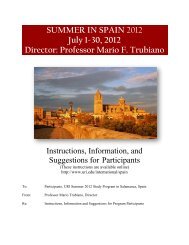Appendix A Standard Operating Procedures - University of Rhode ...
Appendix A Standard Operating Procedures - University of Rhode ...
Appendix A Standard Operating Procedures - University of Rhode ...
Create successful ePaper yourself
Turn your PDF publications into a flip-book with our unique Google optimized e-Paper software.
5.3.2 Preparation - At least 48 Hours Prior to Sampling Day (As Needed)<br />
1. Autoclave an appropriate number <strong>of</strong> bottles for sampling. (Review SOP 005 - Bottle<br />
Autoclaving Procedure). Put sterile labels and sample labels on the bottles.<br />
2. Make up sterile phosphate buffered saline solution (PBS) as needed; 1L <strong>of</strong> PBS is<br />
enough for approximately 25-50 samples. The solution must be room temperature when<br />
used and will need 24 hours to cool. Instructions for preparation <strong>of</strong> the PBS are located<br />
in Section 5.3.2.1.<br />
3. Make sure the water bath and incubator are set to and holding the correct temperatures.<br />
The flask with the thermometer in the white incubator should be full <strong>of</strong> DI water, with the<br />
temperature reading 35 +/- 0.5 C. The water bath should be approximately ¾ full <strong>of</strong> DI<br />
water, and set at 44.5 +/- 0.2 C.<br />
4. Make sure there is enough urea substrate for plate counting. Approximately 3 mL <strong>of</strong><br />
urea substrate is needed per plate. Preparation <strong>of</strong> urea substrate is in Section 5.3.2.3.<br />
5.3.2.1 Preparation <strong>of</strong> 1L Sterile Phosphate Buffered Saline Solution (PBS)<br />
1. Add the following into a 4 L Erlenmeyer flask:<br />
a. 1.25 mL Stock KH2PO4 solution (preparation information in Section 5.3.2.5)<br />
b. 5 mL Stock MgCl2 solution (preparation information in Section 5.3.2.6)<br />
c. 7 g NaCl<br />
d. 1 L DI H2O<br />
2. Stir the mixture using a stirring bar and magnetic stirrer until the NaCl is dissolved.<br />
3. Cover the mouth <strong>of</strong> the flask with aluminum foil and place it on a metal tray.<br />
4. Autoclave the tray and flask for 45 minutes at 121 C (refer to SOP 004 – General<br />
Autoclave Operation).<br />
5. Remove the flask and tray using insulated autoclave gloves as the PBS will be very hot.<br />
6. Leave the flask covered and allow it to cool to room temperature before using.<br />
5.3.2.2 Preparation <strong>of</strong> 4 L Sterile Phosphate Buffered Saline Solution (PBS)<br />
This procedure will prepare enough PBS to fill the safe plastic carboy<br />
1. Add the following to the 6 L plastic carboy<br />
a. 5 mL Stock KH2PO4 solution (preparation information in Section 5.3.2.5)<br />
b. 20 mL Stock MgCl2 solution (preparation information in Section 5.3.2.6)<br />
c. 28 g NaCl<br />
d. 4 L DI H2O<br />
2. Stir the mixture using a stirring bar and magnetic stirrer until the NaCl is dissolved.<br />
3. Set the carboy cap on the mouth <strong>of</strong> the carboy, but DO NOT thread. Place in a metal<br />
tray.<br />
4. Autoclave the tray and carboy for 60 minutes at 121 C. The carboy will have to be laid<br />
on it side to fit into the autoclave. Use beakers or bottles on either side <strong>of</strong> the carboy<br />
handle to brace it, preventing the carboy from rolling around on the tray (refer to SOP<br />
004 – General Autoclave Operation).<br />
11 <strong>of</strong> 23<br />
Ambient Waters Microbiological Procedure SOP 007<br />
S:\WW\awwword\LABPROC\all QAPPs\LABQAPPs\QAPP Rev5 -0609\SOPs\SOP 007AmbientMicrobes.doc



